Today we reminisce about
The House of Sand (2005)
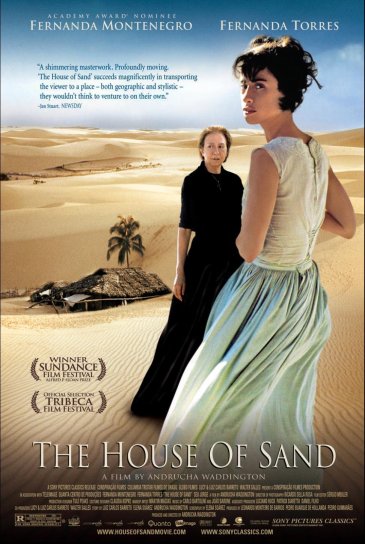
Directed by Andrucha Waddington
Starring: Fernanda Montenegro, Fernanda Torres
* Published specifically for The Luso World Cinema Blogathon hosted by Beth at Spellbound by Movies and Lê at Crítica Retrô *
Narrative
Our story begins in 1910. A group of people is trekking through a harsh countryside in Maranhão, Brazil, that is arid with lots of wind and endless sand dunes. They are led by an older man named Vasco de Sá, the purchaser of a large amount of land in the area, and have been wandering around for over a month in search of the right spot. As Vasco reads the map for signs, he realises that they are close to water meaning that they have finally reached their destination. Although the land is very bare and there are only a few streams of water, vast lagoons will form during the rainy season. The workers begins to establish a permanent settlement, starting with a house for Vasco, his much younger, pregnant wife Áurea (Fernanda Torres), and her mother, Doña Maria (Fernanda Montenegro).
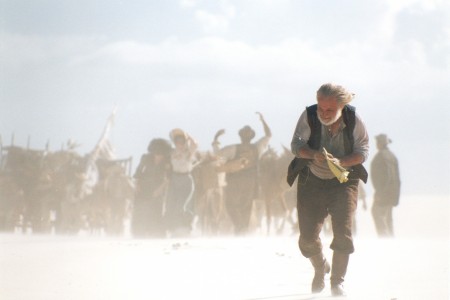
Unhappy having left modern city living and exhausted from the trip, Áurea begs Vasco to give up his crazy idea of making a life in this hostile, isolated environment. He will hear nothing of it and forces her to remain in the house with her mother once it has been completed enough for them to dwell there. It is clear that there is no love lost between the two and that their marriage was one of financial arrangement. Doña Maria, feeling sorry for her daughter and future grandchild, attempts to bribe one of the workers to help them leave but, in the end, the workers end up abandoning the camp and robbing the settlement of all its food. To boot, they encounter fugitive slaves of African ancestry who are hostile at the presence of these white men. In angry haste, Vasco attempts to continue constructing the house himself but is killed when a side of the house collapses onto him. Relieved that they are now free from Vasco’s mad reign, the women attempt to leave on their own but end up turning back, powerless to continue on.
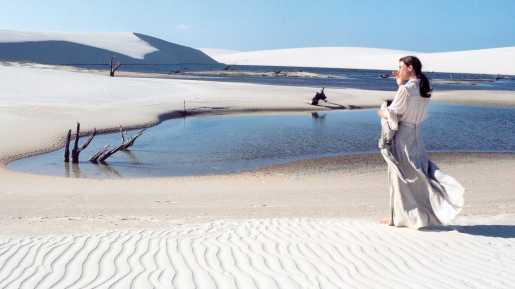
The two women gradually explore their surroundings; leading Doña Maria to meet a local man named Massu who gives her something to eat as well as information about the area. She learns that there is a nearby island which, at rare instances, is accessed by outsiders. For example, Massu’s father owns a shop there and gets salt delivered at inconsistent intervals. (The salt is used to preserve and flavour fish caught in the sea.) Áurea attempts to make plans with the salt delivery man, Chico, to leave the next time he comes but is advised against it by Doña Maria since she is quite far along in her pregnancy. Again, they hope that their stay will only be temporarily lengthened.

The year is now 1919 and Áurea’s daughter, Maria, is an older child. All three women still live in the house originally built for Vasco although it has suffered greatly over time due to a drifting dune that is slowly but surely consuming their homestead. Also, the floods have brought the lagoons dangerously close to the borders of the house. Ultimately, the house will sink and it is only a matter of time before it does. For the past 9 years, Áurea has been able to provide for her family by raising and selling goats. She has had enough and once more decides that it is time to part. The salt vendor is much older now and is hesitant to take solo trips. When he passes away unexpectedly, she is disappointed and, to a point, does not believe that Massu is telling her the truth. She decides to see for herself and heads to the village where Chico died which is a two day walk from her home.
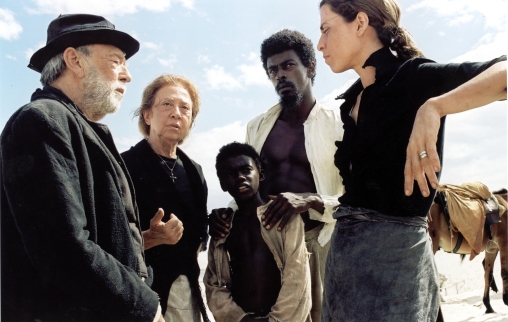
Along the way, she crosses paths with a scientific expedition team that is observing a solar eclipse. A military man named Luiz is helping to guide them through the desert and befriends a very shy Áurea who has not talked to anyone from her outside world in nearly a decade. The two end up falling for each other and make love under the stars. Áurea asks that she, Maria, and her mother tag along on the expedition to finally escape the area, to which the team agrees. She heads back to fetch them and to meet-up with the team as they are on a fixed schedule. When she arrives back home, she sees that the house has caved-in due being overtaken by the dune. She fears the worst and mourns her family until Maria shows up alive, having been rescued by Massu. Unfortunately, Doña Maria did not make it and they bury her body in the sand.
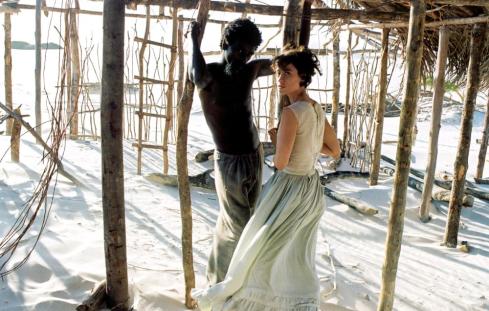
Realising that she has missed yet another chance at freedom, Áurea decides to change her priorities and to take fate into her own hands. She initiates a steamy sexual encounter with Massu which marks the beginning of their union after having been very close acquaintances since her arrival. With Massu and his son, who is about the same age as Maria, they become a family. Áurea dedicates her life to Massu and their many grandchildren on his side. More than 20 years on we see that Maria, however, has gone down a completely different path.
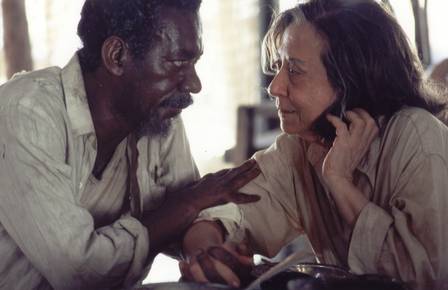
In this film that spans over a period of nearly 60 years, we see the evolution of three generations of women in an unforgiving milieu. Moreover, we witness the damaging effect that isolation has on those shut off from the rest of world. It is as touching as it is damning.
Background
The House of Sand was an ambitious project that was four years in the making from pre- to post-production. Brazilian director Andrucha Waddington took inspiration for the film from a photograph that he saw in a small, mom-and-pop restaurant in Maranhão. The owners told him tale of a woman who lived in a home that was encompassed by a large sand dune. Instead of moving her domicile elsewhere as the locals usually did, she attempted to fight the dune’s intrusion. Her struggle encouraged him to create a story for a feature length motion picture.
Fernanda Montenegro as a young actress and as a wife & mother of two children.
Real life mother and daughter Fernanda Montenegro and Fernanda Torres portray the female characters in the film. Montenegro is one of Brazil’s most celebrated classical actresses with a career spanning well over 50 years. Torres started out as an actress in the early 80s and in the past decade has focused more on writing novels. As she is also married to director Waddington, this film was very much a family affair.
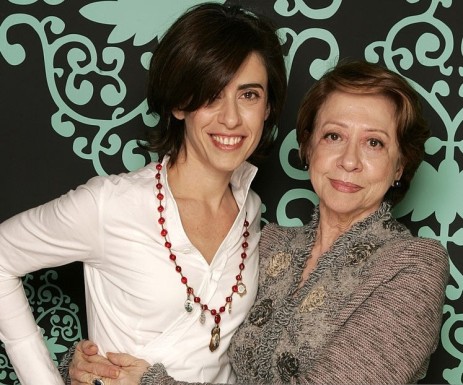
Primary production took place in the Lençóis Maranhenses National Park and the town Santo Amaro do Maranhão which is located in the northeastern part of the state. Santo Amaro served as the cast and crew’s permanent locale but they had to travel 40 km. in order to reach the dunes. Needless to say, transporting equipment and constantly having to deal with sand was very much of a challenge.
Very early on in the film’s planning, it was decided that an extensive soundtrack would not be used. Instead, the producers chose to utilise the sounds of nature – the wind, the sound of moving sand, the sound of wildlife – to accompany the story. There are certain chosen moments when music is played, notably when Áurea visits the scientific expedition team’s camp. As they are celebrating the success of their results in regard to the eclipse, there is a man playing the violin. Much later on at the very end of the film, a middle-aged Maria brings a portable radio to Áurea who is now in her 90’s. Frédéric Chopin’s Opus 28 no. 15*, a powerful and exceptionally beautiful piece of music, is played throughout the last scene and the ending credits.
Thoughts
On the surface, The House of Sand displays a variety of characteristics that could compare it to films such as Lawrence of Arabia, The Piano and The English Patient. All three of those films are set in vast, isolated, difficult landscapes at a time when inhabiting/exploring them was not common. The lead characters are also people who are very resistant and who experience a great deal of heartache before being able to find peace at the closing. Still, The House of Sand remains one of the most original and honest films that I have ever seen. There is nothing pretentious about this picture. This is a story about life that is simple in its presentation but which is so very rich in substance.
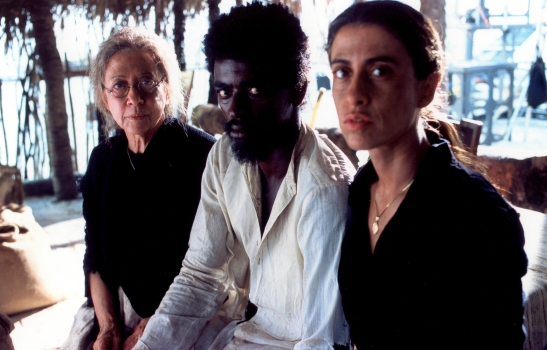
Áurea is the central-most character and a great deal of the story follows her path through life. She is a cultured woman who loved playing the piano in her youth. From the pictures that she shows and the memories that she shares, we see that she comes from a background of privilege. At some point however, her family either lost their wealth or ran out of credit: an event which prompted her marriage to Vasco. He rescued Áurea and Doña Maria from their debts but brought his young wife much unhappiness. The only time that Áurea is shown smiling is where she speaks to Luiz in 1919. She reminisces about her past, listening with both desire and trepidation as he tells her how the world has changed over the past decade. Hearing the scientists’ music makes her weep as it reminds her of something she once loved and which she knows no longer. Being a victim of circumstance is a very tough fate to endure, especially when one is aware of the injustice while pushing their dreams to the side for the sake of others. This is the price that Áurea pays for Massu’s beatitude and eventually also for Maria’s ultimate livelihood.
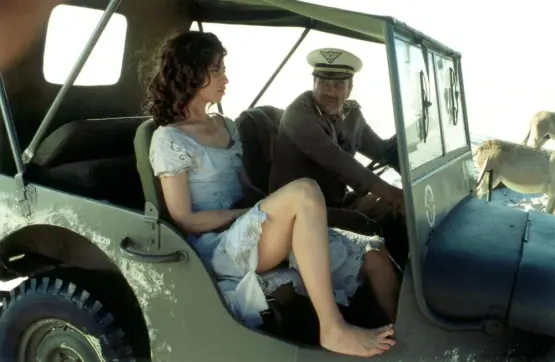
Each person in the film is beautifully played by an exceptional cast who create a sort of magic on-screen. The way that Montenegro and Torres work together in portraying Áurea at different phases of her life is quite remarkable and something that is rarely seen in film. There is no error in the continuity of the character which is something that both actresses worked diligently to get right. This is neither an uplifting film that will boost your morale nor one that will dampen your spirits. Rather, it is a film that makes you think and asks for your patience in order to tell its story. It will make you reflect on life, especially how it crawls by in some moments and flies by at others. I hope that this film is never forgotten because it is just so lovely, especially for the fact that it takes place in an area of the world that is – and will always be – largely obscure to most of the human race. My deepest gratitude goes to everyone involved in this production.







Great piece, Erica. Thanks for the introduction to this film, as I’ve never heard of it until now. Will be on the lookout for this one!
LikeLiked by 1 person
Thanks, Maddy! 🤗
It’s a wonderful film that I think you would really enjoy. I discovered it quite by chance after it first came out. During my University years, I studied about Latin America and took a few years of Portuguese, which was quite difficult. Although I have never gotten to visit S. America, it is still a place that interests me. 😊 I surely hope you can eventually get to see this!
LikeLiked by 1 person
I look forward to it!
LikeLiked by 1 person
Wow! This film looks intensely beautiful due to the landscape, and at the same time you show me how isolating and dangerous it can be for the characters. I’m intrigued to see what happens to them over the many years depicted in the film. Thanks for introducing it to me and for participating in the blogathon!
LikeLiked by 1 person
You are very welcome, Beth, and I am very happy that you and Lê decided to organise this event. 🤗
When films are set in these kinds of environments, it somehow makes you feel powerless because you are constantly preoccupied. I find myself asking how I would manage to survive in similar circumstances, often times finding that it would be very difficult indeed. This was the first time I had ever seen such a landscape so I was puzzled as the same time as I was impressed by its beauty.
It is my hope that you can one day see this brilliant film. I’m so glad that I discovered it and that my husband was kind enough to offer the DVD to me as a gift. ❤
LikeLiked by 1 person
When I watch the film, Erica, I will let you know what I think. I definitely is on my to watch list now!
LikeLiked by 1 person
Thank you so much for presenting English speakers to this film and to the mother-duaghter duo! Fernanda Montenegro recently celebrated her 90th birthday and published an autobiography I intend to buy this Christmas. As for Fernanda Torres, also incredibly talented, some friends told me I look a bit like her – which is curious, since my mother looks a lot like Fernanda Montenegro when she was younger!
Thanks for taking part in our blogathon!
LikeLiked by 1 person
Obrigada, Lê! 😀
I was so happy to finally get to write about this film which is truly a work of art. When I first watched the film, I had no idea that the two Fernandas were mother and daughter. Their transitions in the film are really well done.
It is wonderful that Fernanda Montenegro is still with us. I searched for some interviews with her and found some from a few years ago in which she looked just wonderful. I hope that you enjoy her autobiography! Perhaps it will also be translated into English someday. I can definitely see the resemblance between you and Fernanda Torres. That is very much a compliment! The little girl they chose to play 10-year-old Maria really complimented Torres’ looks.
Thank you and Beth so very much for hosting this wonderful blogathon and I would love to join again if you decide to revive it! Take care! 🙂
LikeLike